2024 NBA Awards: Official picks for MVP, Rookie of the Year and every individual honor
The powers that be at the NBA, in their infinite wisdom, have onceagaingivenme an official ballot for year-end awards. Is that shocking fact — five straight years of Devine votes! — a bigger integrity-of-the-game issue than the whole “turningscoringoff” thing? Not for me to decide, really. History will be the judge.
This is going up a few days before the proper end of the 2023-24 NBA regular season; as such, I reserve the right to make some changes before I submit my ballot ahead of the pencils-down deadline. (Like, for example, if someone I’ve listed here winds up being ruled ineligible based on the league’s new 65-game threshold for awards consideration; I think I’m clear on these, but I might have missed a “not enough games of 20-or-more-minutes” here or there.)
For the most part, though, here’s what my picks for the individual awards will look like (and here are my team awards):
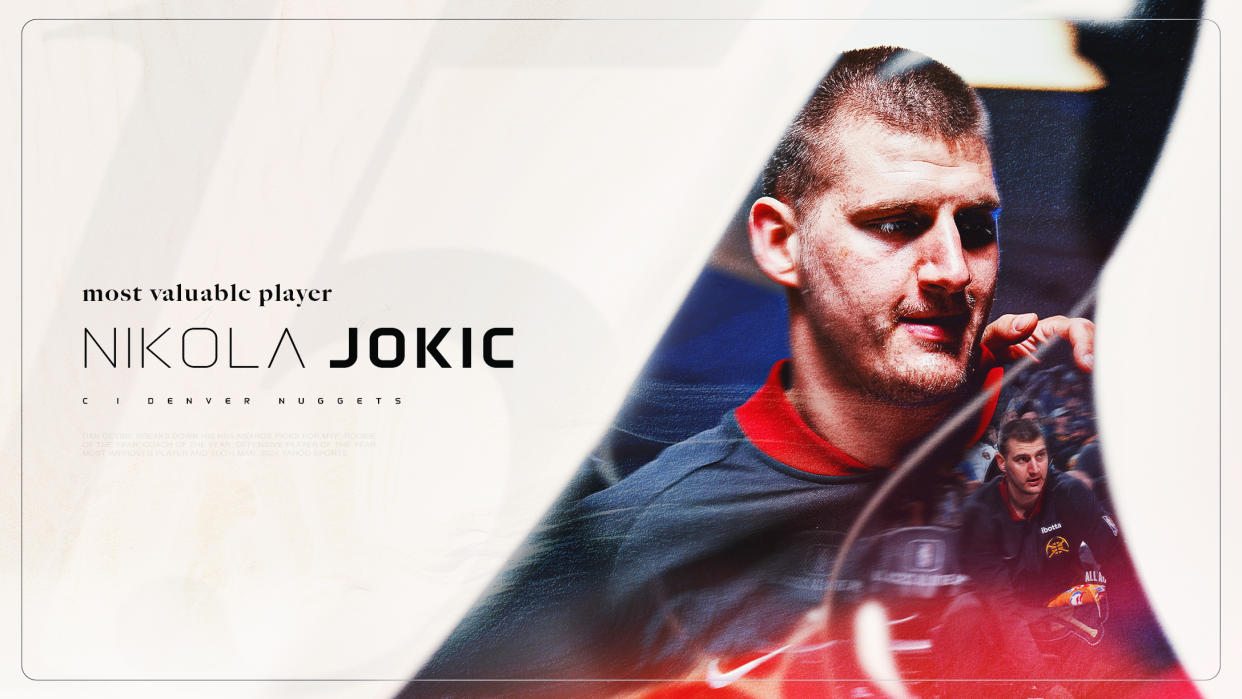
Most Valuable Player
1. Nikola Jokić, Denver Nuggets
2. Luka Dončić, Dallas Mavericks
3. Shai Gilgeous-Alexander, Oklahoma City Thunder
4. Giannis Antetokounmpo, Milwaukee Bucks
5. Jayson Tatum, Boston Celtics
Dončić has been phenomenal all season long, from a torrid opening month that saw him drill 39% of the 10 triples he hoisted per night through the hellacious run he’s been on since the trade deadline — essentially a 33-point triple-double for two months — as the Mavericks have gone from mystery box to marauding conqueror stampeding up the Western Conference standings. He leads the NBA in scoring, averaging 33.9 points per game on career-best shooting efficiency; he’s also second in the NBA in assists per game and third in points created per game via assist. He’s the straw that stirs the drink for a Dallas offense that sits sixth in the NBA in points scored per possession and that scores at a top-three clip with him on the floor to orchestrate.
As Dallas managed a laundry list of injuries — to co-pilot Kyrie Irving, rookie big man Dereck Lively II, wings Josh Green and Dante Exum, frontcourt stalwart Maxi Kleber, and pretty much everybody else in a Mavs uniform, resulting in a whopping 33 different starting lineups — Luka kept it afloat, hovering around the play-in/playoff line. And when reinforcements came in the form of Daniel Gafford and P.J. Washington and everybody else got healthy, the road at long last rose to meet him: Dallas owns the West’s best record and net rating since the trade deadline. (Denver, which kicked into high gear right around the same time, is second and third, respectively.)
The Mavs have topped 50 wins for the second time in Jason Kidd’s tenure, and they’re entering the postseason on fire. Dončić deserves the lion’s share of the credit for that; I believe this is the best basketball that he has ever played.
I just think that Jokić has been even better.
Dončić scores and creates more points via assist than Jokić; Jokić shoots less often but more efficiently, while adding a ton of value (about an additional 10 points per game) as the screen-setting hub of a Nuggets offense that has run neck-and-neck with Dallas, while also serving as the at-the-level-of-the-screen interior anchor of a Nuggets defense that ranks ninth in points allowed per possession.
He edges Dončić, and leads the league, in nearly every advanced statistical metric we’ve got — value over replacement player, player efficiency rating, box plus-minus, win shares per 48 minutes, etc. — while missing only three games for the West’s No. 1 seed. (Dončić has missed 10, though he’s played just 43 fewer minutes overall.) The Nuggets have outscored opponents by 12.6 points-per-100 with Jokić on the floor, a monstrous number; they have annihilated teams by roughly the same margin, if not more, in the minutes he has playedwithout the othermembers of Denver’s elite starting five.
It’s completely defensible to go with Dončić. But the Nuggets, in my view, have been the best team in the West from the start of the season to the end of it, the team I believe in most, and Jokić is the single biggest reason why — the best player on the floor, and in the world, all season long. He gets my vote, and Luka takes second.
Their stellar play, combined with a slight late-season dip and a half-dozen games missed due to injury, bumps Gilgeous-Alexander down to third. Which feels crazy, because he’s been incredible — a full-blown two-way superstar, averaging better than 30 points, five rebounds and six assists per game on .639 true shooting while leading the league in steals for an ahead-of-the-curve Thunder team that’s been scrapping and clawing for first place in the West since the opening tip.
SGA has been the best player on one of the best stories in the NBA — the preternaturally poised, play-at-your-own-pace avatar for the league’s premier drive-and-kick offense, and a point-of-attack menace for an athletic, aggressive, swiping and smothering defense. It felt almost greedy to ask what he could do for an encore after breaking through to All-NBA First Team and a fifth-place finish in MVP voting last season, followed by leading Canada to the medal stand at last summer’s FIBA World Cup. The answer, it turns out: more, more, more — and, for the most part, whatever he wants when he’s got the ball in his hand and a defender all-too-briefly in his path.
The persistent noise in Milwaukee — Terry Stotts’ preseason exit and the early stumbles under Adrian Griffin; Khris Middleton’s injury woes and the tougher-than-expected process of integrating new superstar Damian Lillard; Griffin’s surprise firing and the myriad strangenesses and struggles of the Doc Rivers era; the fact that the Bucks trail the Celtics by 13.5 games in the Eastern standings — has, to some degree, muted the sheer ridiculousness of Antetokounmpo’s season. So let me say loudly: GIANNIS HAS BEEN RIDICULOUS.
Antetokounmpo is the first player ever to average 30 points per game on 60% shooting from the field; he adds 11.5 rebounds and 6.5 assists per game (a career-high!) just for fun. He ranks in the top four or five in virtually every all-in-one advanced stat. He doesn’t just lead the NBA in points in the paint; he’s scored 182 more points there than second place (Jokić) and 300 more than anybody else. Nobody dominates the most valuable real estate in the game to a greater extent; here’s hoping he can kick that calf strain in a hurry and take a shot at willing this up-and-down Bucks team to the kind of championship contention that his talent demands.
Believe me: I understand the push to land Jalen Brunson on the MVP ballot. He’s been a revelation — a true-blue superstar whose relentless attacking in isolation, ongoing growth as a 3-point shooter and off-ball marathoner, and evolution as a monster-usage offensive engine has not only kept New York solvent throughout its many midseason injuries (headlined by the loss of Julius Randle), but within striking distance of the East’s No. 2 seed and a shot at the Knicks’ first 50-win season in 11 years. He’s been a top-10 player by a slew of advanced metrics — a worthy selection.
In my gut, though, I’d feel wrong not going with Tatum. Yes, he benefits from being flanked by the best top six in the NBA, but he’s also the best player on by far the league’s best team. This Celtics squad has not only lapped the East; it leads the NBA in offensive efficiency, ranks third in defensive efficiency and boasts the fifth-highest average margin of victoryever. (It’s a legendary top four: the 1972 Lakers that won 33 straight, the Kareem-and-Oscar 1971 Bucks, the 72-win 1996 Bulls and the Year 1 KD Warriors, all of whom won the championship.)
Brunson holds slight statistical edges in a number of categories. But Tatum’s two-way play and willingness to take a slight step back to make space for newcomers like Kristaps Porziņģis and Jrue Holiday to find their place in the Celtics’ pecking order — and for Jaylen Brown and Derrick White to play the best ball of their respective careers — have gone a long way toward creating the kind of environment that fosters a juggernaut. Tatum’s numbers might be better if he took a different tack; the Celtics, though, are heavy favorites to rampage to a title in large part because of how he’s approached things, and how directly it has influenced winning. As remarkable as Brunson has been, that feels worth a nod to me.
Just missing the cut: Brunson, Anthony Edwards.
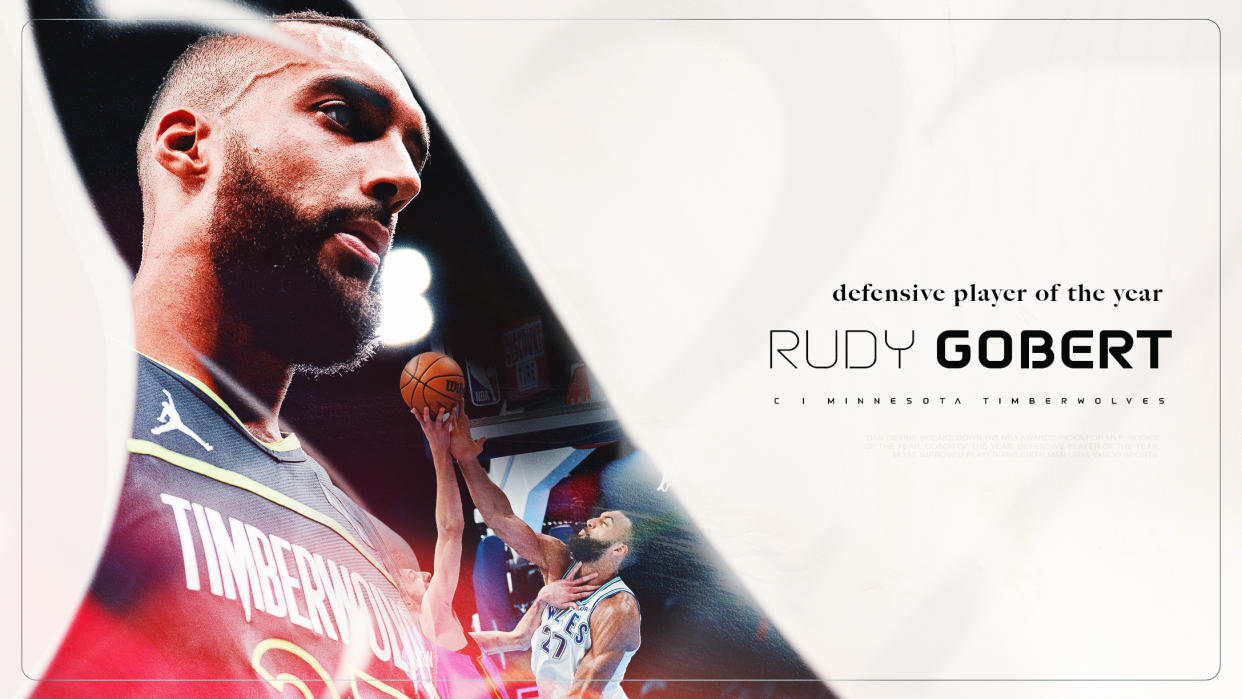
Defensive Player of the Year
1. Rudy Gobert, Minnesota Timberwolves
2. Bam Adebayo, Miami Heat
3. Anthony Davis, Los Angeles Lakers
The Wolves have been the NBA’s best defense all season long, allowing (depending on your advancedstatwebsite of choice) somewhere between 1.5 and 3.0 fewer points per 100 possessions than any other unit in the league. It’s been a historically stingy group — one conceding about 6.5 fewer points-per-100 than the league’s average defense this season, which is the 11th-largest differential of any team since 2000, according to PBP Stats. The biggest reason for that: the biggest guy in blue and white.
Minnesota’s elite defense has been at its most suffocating with Gobert stalking the back line, allowing an infinitesimal 107.6 points-per-100 in his minutes. He’s sixth in the NBA in both blocks per game and contested shots per game, and affects far more shots than he swats. It’s not a coincidence that Wolves opponents take a larger share of their shots from floater range and midrange when Gobert’s in the game than when he’s off it, that they test the rim way less often when he’s in there, or that they convert at the rim at a league-worst rate when he’s patrolling the paint.
You can understand why they so often opt to pull the ball down and dribble out rather than testing him at the rim: Opponents are shooting just 51.8% against him at the basket, according to Second Spectrum. Among 256 players who have guarded at least 100 point-blank attempts, that’s the seventh-lowest percentage — and Gobert’s faced way more challenges than the top six.
And for all the slings and arrows Gobert has faced over the years about getting played off the floor by small-ball because he gets cooked in space … well, he has held would-be chefs to 28-for-78 (35.9%) shooting and 0.73 points per possession in isolation, according to Synergy Sports Technology, forcing turnovers on twice as many possessions as he gets caught out and commits shooting fouls:
This is what Tim Connelly envisioned when he forked over a half-decade’s worth of first-round picks to bring in Gobert: a massive, mauling defense that establishes the sort of elevated floor that wins you 50-plus games, that can match strength and length with the West’s biggest bullies, and that can give you a shot at a level of postseason success that Minnesota’s only lightly grazed in 35 NBA seasons. It took a year, but Gobert has provided it — and, in the process, offered everyone a reminder of just what an all-time great he is on the less glamorous end of the floor.
Nobody knows better than Adebayo just how unglamorous defensive work can be. As the queen on Erik Spoelstra’s lunatic chessboard, forever moving around to snuff out one threat and engage another, he doesn’t even get the benefit of the box-score stats that can prop up other bigs’ cases. But behind the comparatively pedestrian block, steal and deflection numbers lies the beating heart of a Heat team that ranks sixth in Dunks and Threes’ adjusted defensive rating (which factors in the strength of the offenses you’ve faced) — an All-Star whose ability to play the quiet parts loud has gone a long way toward dragging another lackluster Miami offense toward the postseason.
Spoelstra has adjusted the sliders on Miami’s defense this season, shifting from a scheme that often called on Adebayo to switch ball screens, hedge onto ball-handlers before recovering back to his original defensive assignment, or just jump out and blitz the ball out of their hands into one that leans more heavily on conventional drop pick-and-roll coverage. (The Heat have also gone from playing zone on nearly 20% of their defensive possessions last season to just over 13% of the time this season, according to Synergy; that’s still the highest rate in the league, by a decent distance.) The shift has worked largely because Adebayo makes it work.
Miami has guarded at a top-two level overall (111 points-per-100, fewer than anybody but Minnesota) and in the half-court (94.1 points-per-100, and ditto) with Bam on the floor. With him hanging back in the paint more often, the Heat give up shots at the rim less frequently than anyone but Golden State. They also concede far fewer corner 3-pointers in Adebayo’s minutes, thanks in part to his ability to play on a string, rotating from the paint to the arc and back again to douse sparks before they can catch fire. He holds scorers well under one point per possession when he guards them in isolation (just 19-for-67 from the field when they test him), as the ball-handler in the pick-and-rolland in the post; the Heat grab defensive rebounds at a top-two rate with him on the floor.
What Gobert does, he does better than anybody. I’m not sure any defender does everything, though, better than Bam.
This guy might beg to differ.
Whereas Gobert and Adebayo’s teams rank at or near the top of the NBA in points allowed per possession, Davis’ Lakers sit in the middle of the pack: 17th by Cleaning the Glass’ reckoning, 16th via adjusted defensive rating, 19th according to NBA Advanced Stats. Viewed through one lens, that means AD’s not having the kind of elite possession-by-possession impact that other defenders do. Viewed through another, though, it could also mean that he’s got more messes to clean up per capita than just about anybody else in the league — and that getting this collection of point-of-attack defenders to league-average is award-worthy work in and of itself. (Here’s where we note that when you slice out the minutes where AD’s been backstopping Austin Reaves, the Lakers give up a measly 109.2 points-per-100 — near-Wolves territory.)
Davis serves as something like the midpoint between Gobert’s sheer size and rim-protecting intimidation and Adebayo’s everything-everywhere-all-at-once malleability. He can body up Giannis in the paint; he can mirror Paul George on the perimeter; he can pressure a ball-handler 25 feet from the basket and get back to put a lid on the lane. He holds opponents to 54.1% shooting at the rim when he’s the closest defender, a top-15 mark; he’s second in the NBA in steals-plus-blocks.
And while the leader in that category, Victor Wembanyama, has been mind-blowing to watch work in Texas, it matters to me that Davis has played about 550 more minutes than the French phenomenon, all of them while plying his trade in games with stakes for a team fighting for a playoff berth. This award’s going to belong to Big Vic virtually in perpetuity — perhaps as soon as next season. For now, though, AD’s efforts to keep that Lakers defense afloat and in postseason-contending form earn him the nod on this ballot.
Just missing the cut: Wembanyama, Alex Caruso, Jalen Suggs, Herb Jones, Brook Lopez.
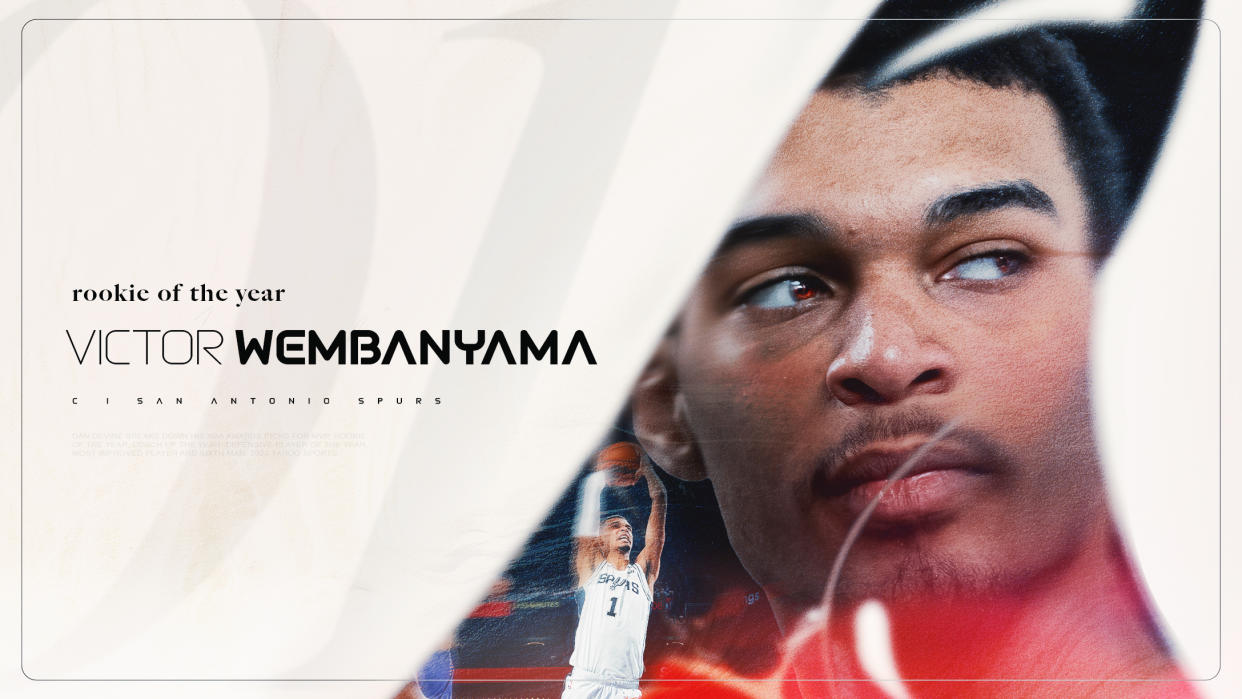
Rookie of the Year
1. Victor Wembanyama, San Antonio Spurs
2. Chet Holmgren, Oklahoma City Thunder
3. Brandon Miller, Charlotte Hornets
At midseason, I gave the nod to Holmgren, in recognition of what I felt was an incredible achievement: being able to come off what amounted to a medical redshirt and not only step into the starting five of a team with playoff hopes, but elevate it to championship contention with his play as a floor-spacing, rim-protecting, closeout-beating postmodern center. And while his 3-point accuracy and playmaking have dipped a touch since the All-Star break, I still feel that; Holmgren has been incredible.
It’s just that the other guy has been more incredible.
Since Dec. 8, when Spurs coach Gregg Popovich moved Zach Collins to the bench so that he could slide his 7-foot-4 wunderkind over to center, Wembanyama has averaged 22.1 points, 11 rebounds, 4.4 assists, 4 blocks and 1.2 steals in 29.3 minutes per game. That’s a 50-plus-game span of him grabbing 20% of available rebounds, assisting on 25% of his teammates’ baskets, blocking more than 10% of opponents’ 2-point shots and maintaining a league-average true shooting percentage (which factors in 2-point, 3-point and free-throw accuracy) despite posting the NBA’s fourth-highest usage rate.
Nobody’s ever done that before. I’m not sure anybody’s ever even considered doing that before.
As impressive as Big Vic’s offensive production has been — the only other rookie to average at least 20 points and 3.5 assists per game while scoring as efficiently as Wemby was Michael friggin’ Jordan — his defensive presence has arguably been even more transformational. With Wembanyama off the floor, the Spurs can’t stop a nosebleed, conceding a woeful 122.7 points per 100 possessions — a clip that would rank below the league-worst Jazz, Wizards and Hornets. With him on it, though, they absolutely suffocate opposing offenses, allowing a minuscule 112.6 points-per-100; only the Timberwolves, Magic and Celtics have been stingier over the course of the full season.
This was hilarious. 3-on-1 fastbreak but no one wanted to challenge Wemby at the rim pic.twitter.com/cuyyeO8P9R
— Jeje Gomez (@JejeGomezNBA) April 10, 2024
It’s hard to hold San Antonio’s dismal win-loss record against Wembanyama, considering A) the comparative lack of high-end talent around him, B) that he spent the first quarter of his first pro season with a power forward playing point guard, and C) the fact that, since mid-December, a Spurs team that has been outscored by more than 250 points overall has actually won the minutes that he’s been on the court. (And, as I recently noted, kind of kicked teams’ asses with Devin Vassell, Tre Jones and Wembanyama on the floor.)
Even as the Spurs have toiled at the bottom of the standings, this season has felt, in a lot of ways, defined not only by Wembanyama’s arrival, but by his persistent unfurling — the degree to which the scope of his abilities and their influence have only expanded and continued to reveal themselves night after night after night. This will be the first honor in his NBA trophy case; the only question, it seems, is how long it will take for him to fill it.
A brief salute, then, for Holmgren as our runner-up:
Holmgren has proven to be the perfect finishing piece to Oklahoma City’s unique offensive puzzle. All that five-out spacing, guard-guard screening and drive-and-kick shot creation only works if the center can hold up his end of the bargain; with his ability to threaten defenses with both his shot (37% from 3-point range on more than four attempts per game) and his off-the-dribble game (6.5 drives to the basket per game, shooting 58% on them), Holmgren can. Combine that with his ever-present impact along the back line for a near-top-five defense — tied for second in the NBA in blocks per game, fourth in contested shots per game, top-10 marks in both opponent field goal percentage at the rim and The BBall Index’s rim-points-saved metric (which measures how much a player’s shot contesting/interior activity lowers opponents’ field-goal percentage below what they’d be expected to shoot) — and you’ve got a pretty incredible player.
In virtually any other year, Holmgren’s metronomically consistent two-way impact for a title contender probably would’ve ended with him hoisting individual hardware. This time around, though, he’ll have to settle for silver — while keeping his eyes set on that big gold ball the Thunder are about to start chasing.
I thought about Jaime Jaquez Jr. for third place, in recognition of how quickly he cemented a rotation role on the defending Eastern Conference champion Heat, how much more he had to play than just about anybody anticipated as Miami meandered through an injury-riddled campaign, and how solid he’s been for Erik Spoelstra. The UCLA product has averaged just under 12 points on 49% shooting, four rebounds, 2.5 assists and a steal in 28 minutes per game, all of them for a team competing for a playoff/play-in berth — games with some actual stakes to them, as opposed to the ostensible scrimmages that the Hornets have been playing for most of this season. Ultimately, though, I went with Miller for the reasons I recently highlighted: the flashes of primary-option scoring potential (just under 20 points per game on 44/37/82 shooting splits since LaMelo Ball went down for good and Terry Rozier was traded), complementary play and multi-positional defensive impact that have made him the brightest spot in another dark season in Charlotte.
Just missing the cut: Jaquez.
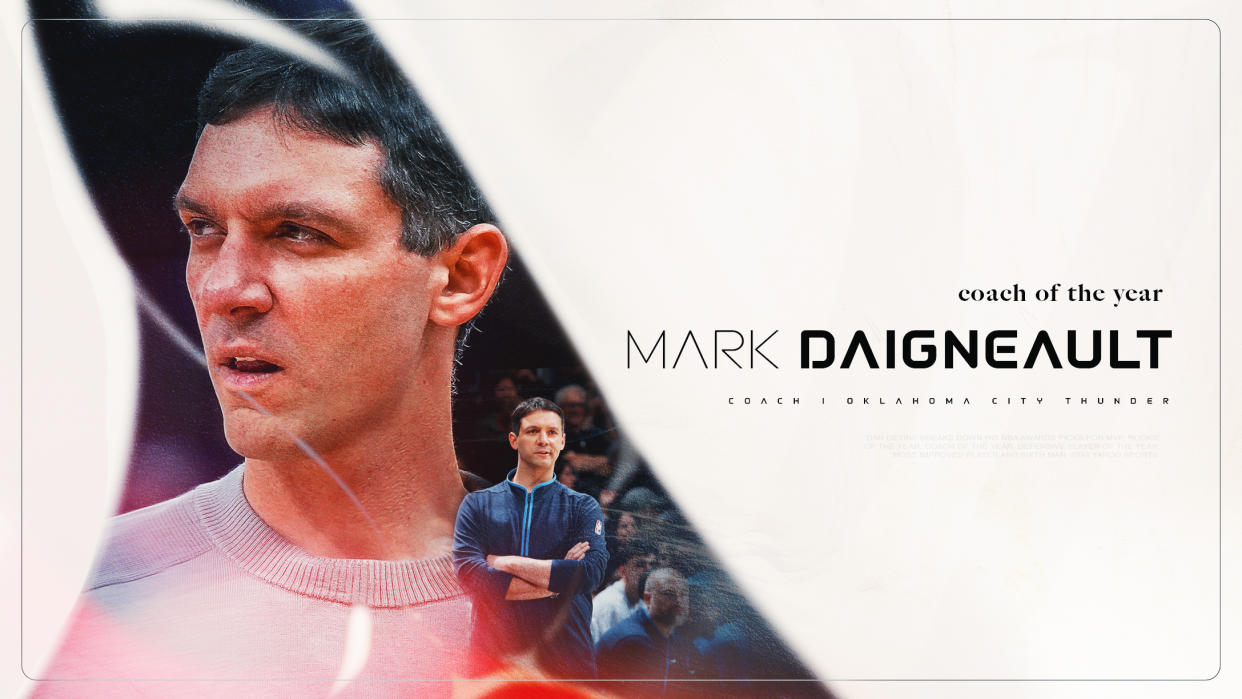
Coach of the Year
1. Mark Daigneault, Oklahoma City Thunder
2. Jamahl Mosley, Orlando Magic
3. Chris Finch, Minnesota Timberwolves
As much as we’ve gotten used to it over the course of the last six months, given the consistency of the outcomes as we check the box scores and standings each night, we shouldn’t lose sight of the fact that it’s freaking nuts that Oklahoma City is this good despite fielding the second-youngest roster in the NBA.
Teams this young typically don’t defend at an elite level; the Thunder are sixth in Dunks and Threes’ adjusted defensive rating (which factors in the strength of the offenses you’ve faced). You’d expect teams this young to struggle to execute in crunch time; OKC is 24-14 in games where the score was within five points in the final five minutes, with a top-three “clutch” offense. This Thunder team — one of only two in the NBA in the top eight on both sides of the ball (Boston’s the other), vying for the West’s No. 1 seed into the final days — has just kept surpassing expectations all season. Daigneault’s stewardship of a franchise that has seen its young core continue to progress and thrive since his arrival is one huge reason why.
You can just about copy-and-paste that case for Mosley. The former longtime Mavericks assistant started to draw praise last season for lifting the Magic from a 5-20 start to an above-.500 mark over the final four months of the 2022-23 campaign and has kept the team chugging along on that trajectory this season en route to Orlando’s most successful season since before Dwight Howard left town.
Mosley has developed an identity in Central Florida, forming a tough, physical, determined collection of hungry youngsters — the league’s fourth-youngest roster — into a top-three defense that can make even the glitziest opposition absolutely miserable. With that baseline in place to keep Orlando in the fight just about every night, Mosley has also steered the Magic’s long-underwhelming offense into meaningful year-over-year growth — from dead-last two seasons ago to 26th last season to 22nd this year — by making up for a lack of long-range shooting through generating more shots at the rim and more free-throw attempts than any other team in the league.
Great coaches tailor their schemes and approaches to their talent, using whatever tools they have at their disposal to get the job done. This Magic roster, with big men who can play like guards and guards who play like big men, functions like a hammer. That’s how Mosley has wielded it, and that’s why the Magic enter the final days of the season with a chance to open the playoffs at home — something I’m not sure many folks saw coming back in September.
Another thing folks didn’t see coming at the start of training camp? The Wolves basically being exactly who their most optimistic adherents thought they could be last season after trading for Rudy Gobert … but before all the injuries, inconsistencies and internecinepunching. And Minnesota bounced back in such a big way due in large part to Finch getting everybody to buy in.
Karl-Anthony Towns could’ve bristled at taking on the responsibility of defending power forwards, spacing the floor for (and passing to!) Gobert and deferring to Anthony Edwards; he didn’t. Gobert could’ve sulked after not getting an All-Star nod despite being the centerpiece of the league-best defense that has driven Minnesota up the standings; he didn’t. Just-got-paid young guys like Edwards and Jaden McDaniels could’ve taken their eye off the ball when it came to their defensive responsibilities; they didn’t. The team could’ve wilted when Towns tore his meniscus in the heat of a race for the No. 1 seed; instead, it kept on rolling, repeatedly rising to the occasion and pushing Denver and Oklahoma City to the limit.
That sort of stability — the capacity to take a haymaker on the chin, shake it off and keep coming — doesn’t just happen. After disappointment and under pressure, the Wolves have stayed the course; attitude, in this case, reflects leadership.
Just missing the cut: Joe Mazzulla, whose creativity and insistence have fueled the Celtics’lapping the league; Michael Malone, who has kept the Nuggets from easing off the gas or succumbing to complacency after their championship win; Tom Thibodeau, who weathered multiple midseason injuries and overhauled his offensive approach to keep the Knicks pushing for a top-three seed; about nine other dudes who’ve all done great jobs.
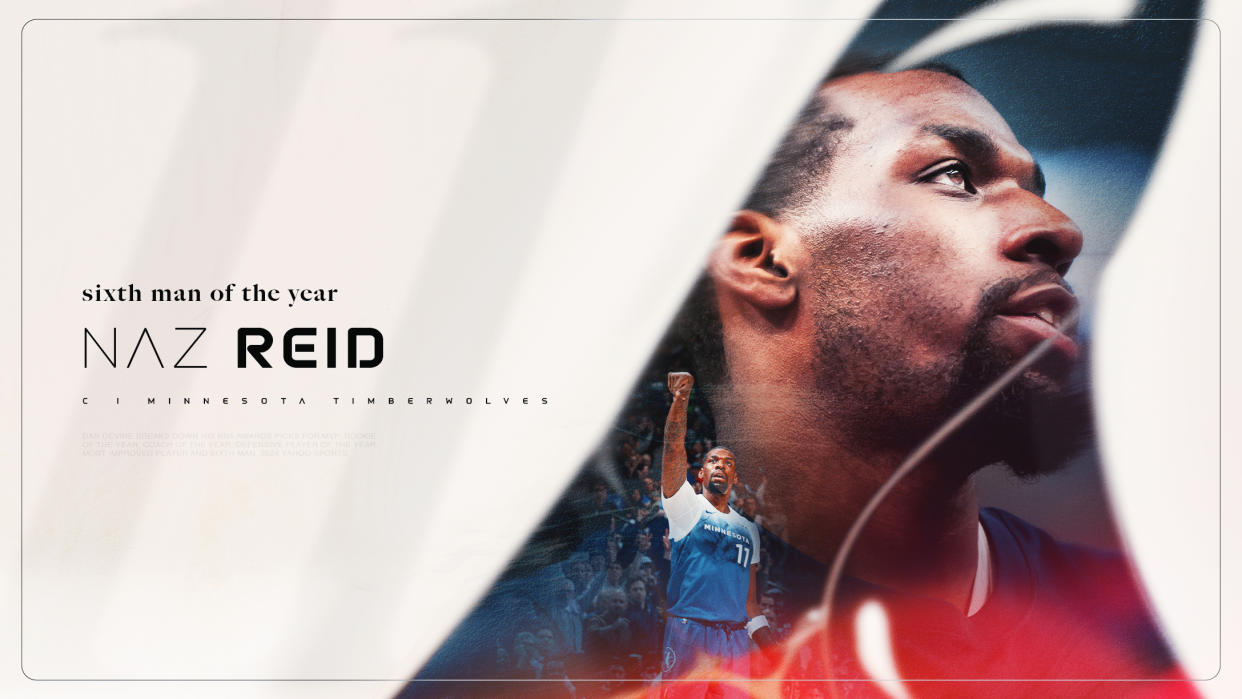
Sixth Man of the Year
1. Naz Reid, Minnesota Timberwolves
2. Malik Monk, Sacramento Kings
3. Norman Powell, L.A. Clippers
I had Monk at midseason, and wouldn’t bat an eye if he winds up going the distance. His scoring (15.4 points per game, second-highest among players who came off the bench at least 40 times) and playmaking (5.1 assists per game, second on that list, too) has been elemental for Sacramento — a needed source of complementary offense to ease the burdens on De’Aaron Fox and Domantas Sabonis, and to fuel a Kings second unit that ranks in the top 10 in offensive efficiency despite lacking another high-end ball-handler or shot creator.
But Monk’s slight second-half dip — just 28.4% from 3-point range, usage rate up but assist rate and scoring efficiency down, Sacramento a net negative in his minutes — opened the door to other contenders … and Reid sprinted through it like he was Eurostepping a mystified defender.
Naz Reid driving euro + lefty layup pic.twitter.com/Dmj3Z8kZeO
— Timberwolves Clips (@WolvesClips) April 8, 2024
I noted Reid as a Sixth Man contender back in mid-December, and he has maintained that high level of play ever since, developing into a perfect third-big complement to Minnesota’s two All-Star big men. The Wolves have outscored opponents by 6.8 points-per-100 in Towns-Reid minutes with Gobert sitting, according to PBP Stats, and by 9.9 points-per-100 in Gobert-Reid minutes with KAT on the bench.
There have been a lot more of those of late, of course, with Towns on the mend following a meniscus tear. Reid has done a tremendous job filling the void, averaging just under 18 points and seven assists in 29 minutes per game since Towns’ injury, shooting a blistering 44.1% from 3-point land on nearly seven attempts per game — long-distance production that’d give KAT himself a run for his money.
Some observers, many of them likely hailing from California’s capital, will cry foul at highlighting Reid’s work in the 13 starts he’s made since Towns’ injury — a “spirit of the award” argument against judging a bench award for numbers racked up in starts. I didn’t find that argument persuasive last season when it was made against Immanuel Quickley in favor of Malcolm Brogdon, and I don’t find it persuasive now. Even so: The Wolves blew teams’ doors off by 7.2 points-per-100 in Reid’s minutes during the 65 games he came off the bench, with the 12.5 points, 4.9 rebounds and .600 true shooting percentage that Reid mustered in those minutes doing a lot of the heavy lifting in those Minnesota maulings.
The Wolves’ success this season has been predicated largely on their ability to stay huge almost all the time and to do so without sacrificing skill. They’ve been able to play to that identity because Reid embodies it; they’ve been able to ride it as far as they have because he’s answered the call time and time again.
Powell gets the final slot for his role in supercharging a Clippers offense that, even after a rocky couple of months, sits at third in the NBA in points scored per possession — and that has scored even more efficiently in his minutes. (The only Clippers with better on-court/off-court splits than Powell this season? Kawhi Leonard, Paul George and James Harden.)
The 30-year-old guard is a plug-and-play source of complementary offense, adept at getting downhill, finishing in the paint and pulling up to stroke a midrange J. Most importantly, though, he provides a lethal spot-up threat who can take advantage of all the attention the likes of Leonard, George and Harden draw from opposing defenses: Powell has drilled 49.8% of his catch-and-shoot triples this season — third-best among more than 230 players who’ve taken at least 100 such shots, according to Second Spectrum’s tracking.
Just missing the cut: Bogdan Bogdanović; Bobby Portis; Cole Anthony and Mo Wagner as part of the second-unit wrecking crew in Orlando.
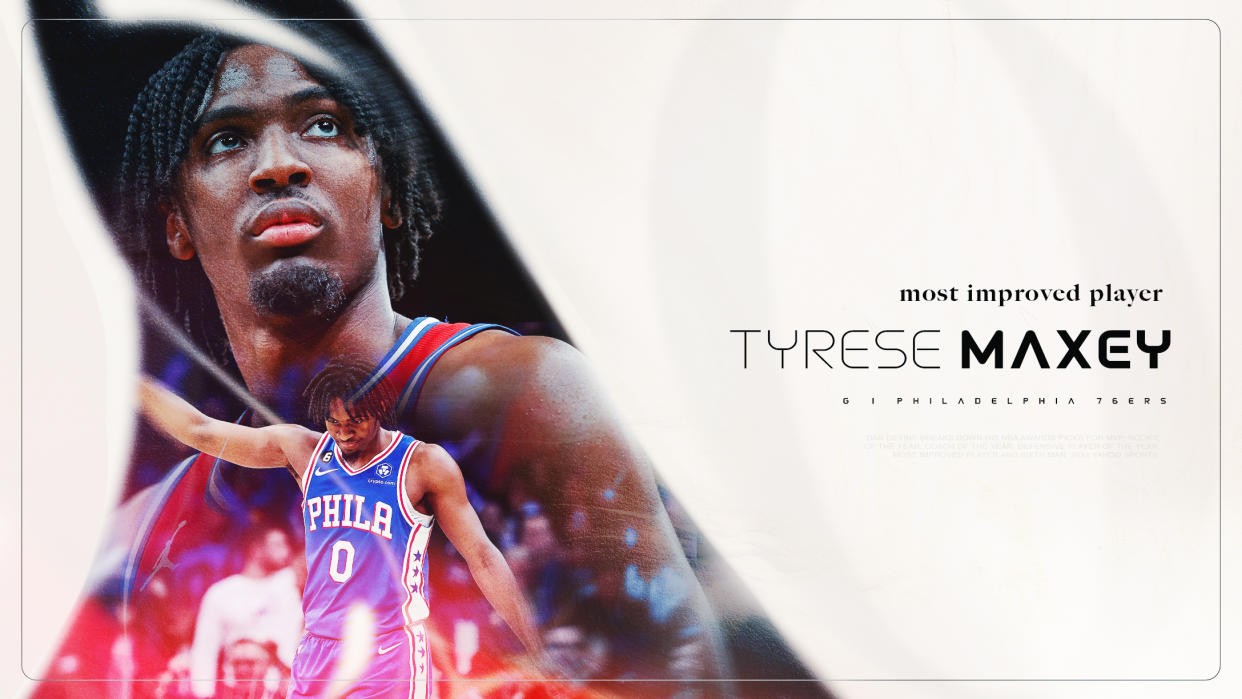
Most Improved Player
1. Tyrese Maxey, Philadelphia 76ers
2. Coby White, Chicago Bulls
3. Jalen Williams, Oklahoma City Thunder
I dove into Williams’ growth last month, so I won’t belabor it too much here. Suffice it to say that, even with the caveat that second-year players are supposed to improve from their first to second year, the sheer size of Williams’ leap — scoring up more than five points per game, assist rate up and turnover rate down, shooting efficiency up from every part of the floor even as his usage rate climbed by nearly 6%, a scorching 68.3% mark (28-for-41) in the clutch, guarding everyone from Victor Wembanyama to Kyrie Irving — in major minutes and games of consequence for a title contender earns him a spot on my ballot.
White profiles as a neater fit in the more conventional framing of the award: a fifth-year player who’d shown fits-and-starts flashes in the past who gets a bigger opportunity — in this case, following the early-season injury to starting shooting guard Zach LaVine — and seizes the everlovin’ bejeezus out of it, increasing his scoring by more than 10 points per game and placing himself squarely at the center of the Bulls’ offensive attack.
Since LaVine went down at the end of November, White has led the Bulls in touches per game, spent more time on the ball than any Bull besides DeMar DeRozan and played more minutes per game than anybody but DeRozan and Luka Dončić, and averaged 20.8 points, 5.2 rebounds and 5.5 assists per game on 45/38/84 shooting splits. That kind of production is the province of All-Stars — the sort of big-time offensive engines in whose company White might’ve seemed like an awkward fit before this season … but alongside whom he slots in more comfortably now that he’s became one of the most important factors in propelling an often-underwhelming team to postseason play.
Speaking of “propelling a team to postseason play” …
Maxey announced his presence in this particular race in the opening days of the season, scoring 91 points on 56 shots in the Sixers’ first three games to make it clear that it was totally OK for Daryl Morey to pull the trigger on that Harden deal whenever he felt like it, because Philly had point guard covered.
The fourth-year guard sits 12th in the NBA in scoring and tied for 17th in assists, averaging 25.9 points, 6.3 dimes and 3.7 rebounds per game, all career highs, while playing the third-most minutes in the league. Maxey has balanced out his blinding end-to-end speed and instant acceleration off the dribble by becoming one of the league’s most dangerous 3-point threats; he’s one of just 14 players to make at least 100 pull-up triples, and he’s knocked down 44.8% of his catch-and-shoot looks from distance, the 12th-best mark among 237 players with at least 100 attempts, according to Second Spectrum. And despite assuming the largest creative workload of his career and dishing out helpers more often than ever, he’s also slashed his turnover rate to a microscopic 6.8% — the lowest turnover rate of any player who’s using more than a quarter of his team’s offensive possessions, according to Stathead.
Maxey’s combination of three-level scoring prowess, improved shooting efficiency, advancing facilitation in the pick-and-roll game and remarkable caretaking has allowed him to help keep the Sixers afloat without supernova center Joel Embiid, whether in the minutes he hits the bench or, for just over two months while the reigning MVP was healing up after meniscus surgery, while he was convalescing. The 76ers have outscored their opposition for the full season when Maxey plays without Embiid, according to Cleaning the Glass, with a league-average offense — which, given how many other injuries Philly’s had to withstand during these brutal past couple of months, represents a fairly miraculous effort by the 23-year-old.
As ecstatic as everyone in Philadelphia was to see the Kentucky product fall to the 21st pick in the 2020 NBA Draft, I’m not sure anyone saw Maxey becoming this: not only a quality starting point guard, but a legit No. 2 scoring option, one of the best high-volume shooters in the league, a bona fide All-Star, and a dependable, tough-as-hell running buddy for the big fella. When you become all of that and then some … well, that’s the kind of thing they give out trophies for.
Just missing the cut: Jonathan Kuminga, who blossomed amid a chaotic season in Golden State; Jalen Johnson, a major bright spot in Atlanta; Herb Jones and Jalen Suggs, a pair of All-Defensive-caliber on-ball menaces who worked themselves into 40% 3-point shooters, fundamentally changing both their and their teams’ prospects; Duncan Robinson, a longtime sniper who’s sharpened his off-the-bounce game and playmaking touch, notching career highs in both drives and assists; Donte DiVincenzo, who transformed himself into — no joke — a Steph-and-Klay-level 3-point bomber; Deni Avdija, whose advancing offensive game I recently highlighted.
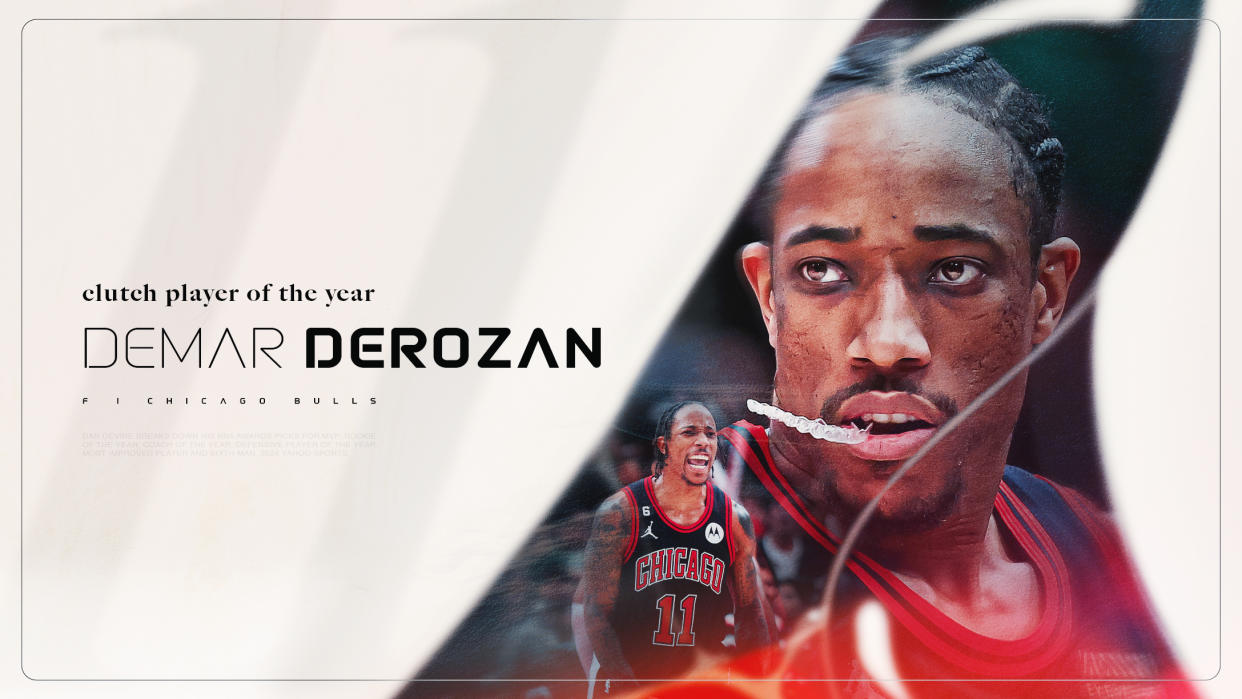
Clutch Player of the Year
1. DeMar DeRozan, Chicago Bulls
2. Shai Gilgeous-Alexander, Oklahoma City Thunder
3. Nikola Jokić, Denver Nuggets
With all due respect to SGA and Jokić, both of whom are shooting 58% in crunch time and man the controls of elite late-game offenses that repeatedly generate good looks in the guts of the game, I wanted to veer away from the MVP candidates a bit in favor of honoring someone whose late-game shot-creation and shot-making might literally be the difference between the postseason and the lottery for his team.
The main reason the Bulls are going to make the play-in tournament again, despite being in the bottom 10 in offensive and defensive efficiency over the course of the full season, is that they have been disproportionately good in crunch time — a sterling 26-16 in games where the score was within five points in the final five minutes. (Which means, when you do the quick math, that the Bulls are 11-26 in all other games. Significantly less sterling!)
The main reason for that — for the Bulls scoring nearly 121 points-per-100 in close-and-late situations — wears No. 11:
DeRozan has scored 177 points in 106 “clutch” minutes this season, behind only Stephen Curry, while shooting 50% from the floor on some of the toughest pull-up jumpers you’re ever going to see. Fifteen years deep, he’s become such a master of his craft that every single scouting report insists you not jump at his up-fake — and yet he’s drawn 45 fouls in crunch time, netting him 73 free-throw attempts, both of which lead the league.
As frustrating as it is to get your hand caught in the cookie jar, though, it’s not nearly as frustrating as what can happen if you don’t get too physical — namely, watching one of the most decorated scorers of his generation walk you down to his spot, get you leaning and raise up for that patented midrange J that he’s been splashing for ages. When the Bulls need a bucket late, the defense knows where the ball’s going. But knowing what’s coming is one thing; stopping it is another.
Just missing the cut: Dončić, Giannis, Steph, J-Dub.
